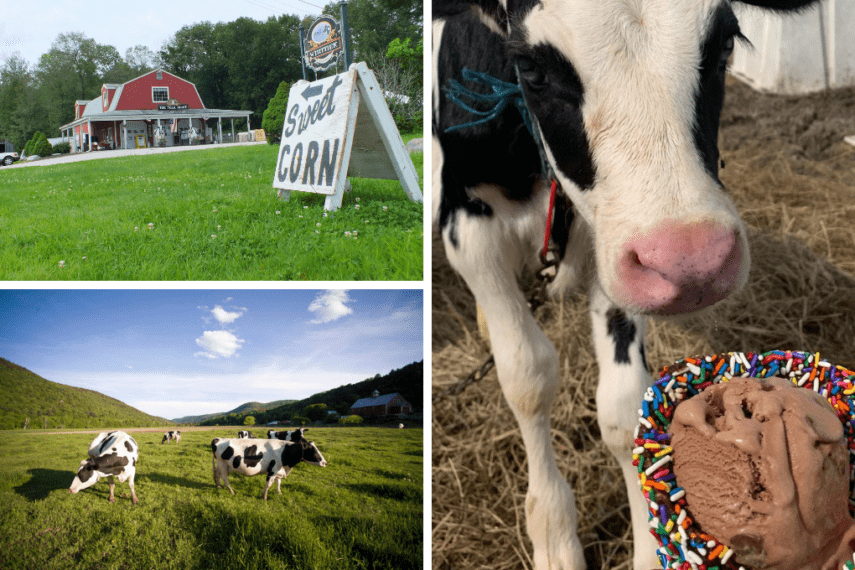
The crops have been harvested for the year, and the cows are tucked into the barns. So, what does winter farming look like in New England? Here’s a list of 8 things our New England dairy farmers are up to over the winter.
1) Farmers Use Cover Crops to Enrich Soil and Fight Climate Change
 Without healthy soil, we lose carbon into the air, crops suffer, and soil washes away in heavy rains.
Without healthy soil, we lose carbon into the air, crops suffer, and soil washes away in heavy rains.
To prevent their soil from degrading, farmers keep the growing season going 365 days a year with cover crops, like this resilient winter rye. It’s growing right now on farm fields throughout New England. Farmers plant it in the fall and it will continue to grow through the winter.
Cover crops sequester carbon, hold water, and enrich the soil with nutrients through the winter. The photo above was taken in mid-November in Vermont. In the past, after the corn was harvested, this land would have been left bare in the winter.
Today, about 30% of Vermont’s cornfields have a cover crop planted in the fall (~26,000 acres). The U.S. average is only 5%. Our New England dairy farmers are doing a great job leading the way with implentation of this practice.
University of Vermont Extension agronomists estimate that if all 80,000 acres of Vermont’s annual cropland was cover cropped, the carbon sequestration would be equivalent to taking 51,290 cars off the road!
The next time you drive by a farm field, look for cover crops. This innovative winter farming practice is saving our soil and is helping in the fight against climate change.
2) Smart Barns

Mother nature is anything but reliable in New England.
Modern free-stall dairy barns are equipped with automatic curtains that rise when the temperature drops to a certain point. These retractable curtains act as a windbreak to prevent drafts, moisture, and snow from entering the barn. In older barns, farmers may manually add protective curtains over naturally open sides on extra cold days. Farmers can adjust based on the type of barn and the weather.
Also, body heat generated by cows together as a herd keeps barn interiors up to 30 degrees warmer than outside. In general, dairy cows thrive in cooler temperatures, preferring 40 and 65 degrees. Since cows are ruminants (four stomach chambers), their largest stomach compartment is like a big fermentation vat, meaning their digestive process helps to keep them warm.
Nearly all farms in the region are equipped with one or more generators to keep the power on should there be a heavy snow or ice storm that impacts the power grid.
3) Dairy Farmers Keep Calves Warm With Jackets
 While adult cows naturally handle cooler temperatures well, dairy farmers take extra precautions to keep calves who are still growing as warm and as comfortable as possible.
While adult cows naturally handle cooler temperatures well, dairy farmers take extra precautions to keep calves who are still growing as warm and as comfortable as possible.
Dairy farmers use calf jackets to help calves conserve heat. These are washable jackets with a quilted inside and often have a windbreaker-like outside. This allows the calves to use their extra energy to grow strong, rather than keep warm.
Calves are already adorable. Add a cute little jacket and you can’t help but smile!
4) Sharing Joy in Local Communities

From preparing meals for their local first responders to tractor parades, dairy farmers look for ways to spread kindness and joy in their communities.
- The St. Albans Tractor Parade in Vermont is a local favorite. Farmers decorate their tractors and parade them through the streets of St. Albans, VT.
- Similar to dairy farmers, the work of a first responder is never done. Many local farm families cook meals for their neighborhood first responders to thank them for their service during the holidays.
- Many dairy farms also sell holiday décor (some even have Christmas trees), baked goods and other treats. Check out our New England Dairy Holiday Guide that features festive farms with socially distant events, treats, and unique gifts.
- Many dairy farms add holiday lights around the farm, lifting the spirits of those who drive by the farm at night.
5) Farmers Change How They Manage Manure

Vermont dairy farmer Marie Audet often says, cow manure is not waste, it’s a valuable source of natural fertilizer that helps crops get the nutrients they need to grow. Using cow manure prevents the need for putting synthetic or chemical fertilizers on farm fields.
But in the wintertime, if the ground is frozen or covered in snow, spreading manure is generally not done.
When farmers spread manure, it needs to soak into the ground. Each state has different rules for when and how to apply manure as part of winter farming practices.
You can check here to see if your state has a winter ban or any limitations on spreading manure. In Massachusetts for example, regulations include not spreading manure within 200 feet of a water source unless it is incorporated into the soil within 72 hours.
Because dairy farmers need to store most of their manure over the winter, there are multiple manure storage options. Engineers and state regulators help design manure pits and above-ground manure storage. They help ensure that the capacity will be right for the farm’s needs and that the manure storage will be environmentally sound. Some farms stack their manure in a pile in designated areas that follow best practices through a nutrient management plan.
6) A Cow’s Winter Diet
 For many of us, the winter is a time when we turn to comfort foods — a warm bowl of mac-n-cheese for example. Similar changes happen on the farm to keep dairy cows fueled and energized. During winter months, cows need more calories to keep warm. Dairy cows across New England are fed a mix of foods call Total Mixed Ration (TMR), think of this as a cow casserole. A milking cow eats about 100 pounds of feed each day — an amount that can increase anywhere from an extra 20% to 40% during winter months. As their food intake increases, so do their water needs.
For many of us, the winter is a time when we turn to comfort foods — a warm bowl of mac-n-cheese for example. Similar changes happen on the farm to keep dairy cows fueled and energized. During winter months, cows need more calories to keep warm. Dairy cows across New England are fed a mix of foods call Total Mixed Ration (TMR), think of this as a cow casserole. A milking cow eats about 100 pounds of feed each day — an amount that can increase anywhere from an extra 20% to 40% during winter months. As their food intake increases, so do their water needs.
Dairy cow feed is a mixture of hay, grain, silage and proteins, plus other vitamins and minerals. Mixing in other materials like spent brewers’ and distillers’ grains or citrus pulp can help provide vitamin and mineral needs. Dairy farmers across New England work alongside dairy nutritionists who help to tailor the right mix of foods for cows. Farmers and nutritionists work to find the perfect balance of energy, fat, protein, and carbohydrates. And that balance can differ from cow to cow. Their diet is based on the cow’s breed, their age, how long it’s been since the cow has calved and other environmental factors like weather and temperature.
Young calves are especially vulnerable to cold temperatures. Farmers take extra precautions to protect their young calves. When it comes to diet, calves may require more frequent and higher amounts of food to keep their energy levels high.
7) Staying Safe in Winter Months

During the cold winter months, farmers remain dedicated to keeping the farm a safe place. Farmers ensure that employees are dressing in warm layers and taking adequate breaks from the cold to keep staff safe and healthy.
In the winter, farmers are diligent about keeping on-farm roads clear of ice and snow. Regardless of the weather, cows continue to produce milk that must be taken to the processing plant for it to reach local store shelves within 48 hours. Especially in icy conditions, on-farm roadways need to be clear for milk truck drivers to safely pick up the farm’s milk.
In parts of New England with heavy snowfall, a top priority is removing snow from barn roofs. Accumulating snow quickly becomes heavy, increasing the risk of roof collapse.
8) Adventures in Keeping the Water Flowing

Food is a human necessity. All foods, plant or animal-derived, require water to bring them to the table. Thanks to modern and innovative dairy farming practices, such as recycling and repurposing water, producing a gallon of milk in 2017 required 30% less water than ten years ago.
Here in New England, dairy farmers typically use water in the following ways:
- Water pre-cools the warm milk down to 50 degrees as it travels from the cow through cooling plates to the bulk refrigerated tank. This reduces energy requirements from the refrigeration system which will cool the milk further to 40 degrees.
- Cooling water is re-used to clean the barn stalls, and is then stored in the manure pit to be recycled on the fields in the spring.
- A cow drinks about a bathtub of water each day, which is piped into the barn into troughs.
Now that you know how water is used on the farm, you can imagine why frozen pipes are a big concern when the temperatures drop. This can be stressful for farmers who need water urgently to keep the farm in operation.
Here are some ways farmers keep their water flowing in the winter:
- Water troughs have thermostats that are connected to a heater. The heaters keep the water above freezing for the cows to drink.
- The milkhouse, where milk is stored, is heated to prevent the water pipes that cool the milk from freezing.
- If the power goes out, farms have back-up generators to keep the water and everything else running. Generators are often hooked up to the Power Take-Off (PTO) shaft of a tractor as an efficient means of transferring mechanical power between the tractor and the generator.



